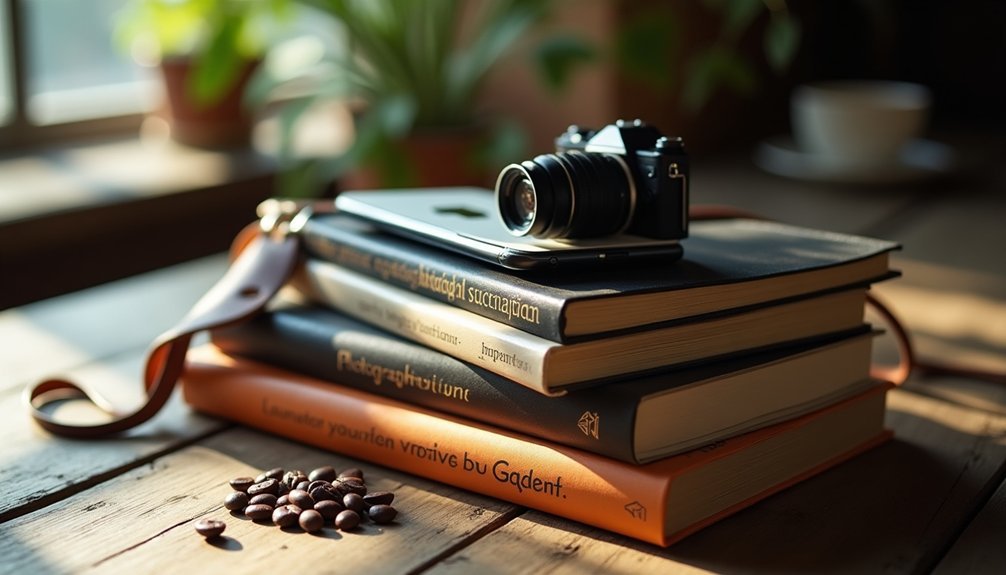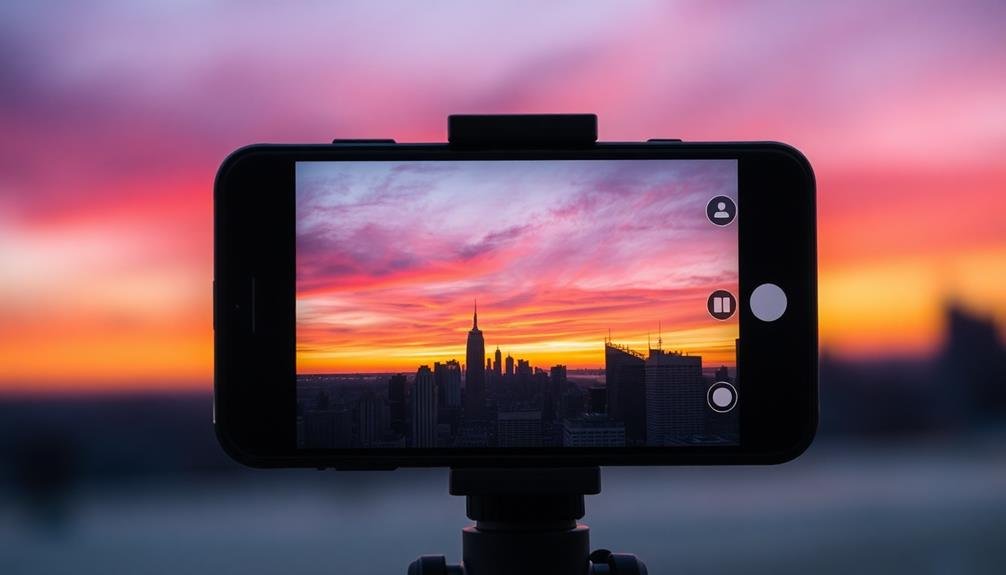Want to elevate your Instagram presence beyond basic filters and quick snapshots? You've likely noticed how some accounts consistently produce stunning mobile photography that draws thousands of likes and followers. While natural talent plays a role, the real secret often lies in understanding core photography principles and mobile-specific techniques. These seven carefully selected books hold the expertise you're looking for, whether you're shooting street scenes or crafting the perfect flat lay.
National Geographic Photo Basics: Guide to Great Photography
National Geographic's Photo Basics stands out as a beginner-friendly guide that breaks down photography fundamentals into digestible lessons. You'll find 10 chapters filled with 8-10 two-page lessons, each accompanied by practical exercises to help you master essential techniques.
What makes this guide particularly valuable for mobile photography is its visual approach. The book's beautiful color photographs serve as clear examples, making it easy to understand and apply concepts to your Instagram shots. While it's not exclusively focused on mobile photography, you'll find the basic principles translate perfectly to your smartphone camera. It's a resource you can revisit repeatedly as you develop your skills.
Best For: Beginning photographers and photography enthusiasts who want a structured, visual approach to learning fundamental photography skills and techniques.
Pros:
- Clear, well-organized content with bite-sized lessons and practical exercises
- Rich visual examples through high-quality photographs that aid understanding
- Accessible writing style that makes complex photography concepts easy to grasp
Cons:
- May be too basic for intermediate or advanced photographers
- Not specifically focused on mobile or smartphone photography
- Limited to fundamental concepts rather than advanced technical details
Digital Photography Complete Course by DK
The Digital Photography Complete Course by DK offers a thorough 20-week learning journey that's particularly valuable for aspiring photographers who prefer structured education. You'll find well-organized modules covering essential topics like exposure, contrast, and depth of field.
What sets this book apart is its extensive learning format. Each module includes pre-assessments, clear theory explanations, and practical assignments to help you master the concepts. The easy-to-read layout features helpful diagrams, bullet points, and high-quality images. Whether you're teaching photography or learning independently, you'll appreciate the built-in quizzes, hands-on exercises, and self-assessments that reinforce your understanding at every step.
Best For: Beginning and intermediate photographers seeking a structured, comprehensive learning path with clear progression through fundamental photography concepts.
Pros:
- Clearly organized 20-week curriculum with progressive learning modules and self-assessment tools
- Comprehensive coverage of photography basics with high-quality visual examples and practical exercises
- Versatile format suitable for both self-study and classroom teaching
Cons:
- May be too structured for photographers who prefer a more flexible learning approach
- Some topics could benefit from more in-depth coverage
- Weekly format might be too rigid for those who want to learn at their own pace
The Art of iPhoneography: A Guide to Mobile Creativity
Photography enthusiasts seeking to master their iPhone's camera capabilities will find invaluable guidance in Stephanie Roberts' extensive guide to iPhoneography.
You'll learn essential techniques through extensive app tutorials, featuring popular tools like Hipstamatic, Camera+, and Photoshop Express. The book introduces you to nine accomplished iPhoneographers who demonstrate diverse creative approaches while encouraging community engagement.
Beyond technical instruction, you'll discover project ideas and creative exercises that'll transform how you view the world through your lens. Whether you're a beginner or experienced photographer, Roberts' resource guide connects you to leading websites, image outlets, and blogs, empowering your journey into mobile photography's expanding universe.
Best For: iPhone photographers of all skill levels looking to enhance their mobile photography skills, learn essential apps and techniques, and connect with the iPhoneography community.
Pros:
- Comprehensive coverage of popular photo editing apps and tools with detailed tutorials
- Features insights from nine accomplished iPhoneographers providing diverse creative perspectives
- Includes practical project ideas, creative exercises, and valuable resources for continued learning
Cons:
- Content may become dated as apps and iPhone camera technology evolve
- Specifically focused on iPhone users, excluding other mobile device photographers
- Some advanced photographers might find basic sections too elementary
How Do I Do That In Lightroom? Quick Guide (3rd Edition)
Mastering Lightroom becomes remarkably accessible with Scott Kelby's "How Do I Do That In Lightroom?" This practical guide serves as your go-to reference manual, particularly if you're shifting from mobile to classic Lightroom.
You'll appreciate the book's intuitive organization, where you can quickly find answers to specific editing questions without wading through unnecessary details. Kelby's approachable writing style and humor make complex techniques less intimidating, while the indexed format guarantees you'll find solutions efficiently. Though it's not for complete beginners, and some may find the physical book heavy, it's an invaluable resource that'll help you navigate Lightroom's tools with confidence.
Best For: Intermediate Lightroom users seeking quick solutions to specific editing tasks and those transitioning from Lightroom mobile to classic version who need a practical reference guide.
Pros:
- Intuitive organization with easy-to-find answers through indexed format and clear headlines
- Engaging, approachable writing style with helpful humor that makes learning more enjoyable
- Efficient quick-reference format that helps users find specific solutions without unnecessary details
Cons:
- Physical book is heavy due to paper weight, making it somewhat cumbersome to handle
- Not suitable for complete beginners who need more basic instruction
- May lack depth for advanced users seeking comprehensive technical knowledge
The Photographer's Eye: Composition and Design for Digital Photos
Considered a cornerstone resource for both novice and experienced photographers, Michael Freeman's "The Photographer's Eye: Composition and Design for Digital Photos" masterfully bridges artistic vision with practical design principles.
You'll find the book divided into two distinct sections: concrete image design fundamentals and abstract elements of photographic intent. Freeman emphasizes camera-eye relationships and framing over post-production, helping you develop a stronger artistic vision. The book's superb illustrations complement the analytical writing style, making complex concepts accessible. While it's not a technical manual about camera settings, it'll transform how you think about composition and visual storytelling. It's particularly valuable if you're looking to understand the psychology behind compelling photographs.
Best For: Photographers at any skill level who want to deepen their understanding of composition, design principles, and the artistic elements of photography beyond technical camera operations.
Pros:
- Comprehensive coverage of both fundamental and advanced composition concepts with high-quality illustrations
- Clear, analytical writing style that makes complex design principles accessible
- Effectively combines practical instruction with theoretical understanding of visual psychology
Cons:
- Not focused on technical camera settings or post-production techniques
- Requires dedicated reading and study rather than quick reference
- May be too philosophical or abstract for those seeking purely practical photography tips
iPhone: The Missing Manual: The Book That Should Have Been in the Box
David Pogue's thorough guide serves as an essential companion for iPhone users who want to access their device's full potential. Written in plain English with full-color photos, this all-encompassing manual helps you reveal hidden features and navigate complex functions with ease.
While it's particularly helpful for iPhone 7 through iPhone 11 users, the book's strength lies in its approachable format and detailed troubleshooting guidance. You'll find clear explanations of iOS 13 features, time-saving tips, and tricks you might've never discovered on your own. Whether you're a smartphone novice or looking to enhance your iPhone expertise, you'll appreciate the well-organized content that lets you learn at your own pace.
Best For: New iPhone users and those seeking to better understand their device's features, particularly those with iPhone models 7 through 11 who want comprehensive, easy-to-follow guidance.
Pros:
- Written in clear, accessible language with helpful illustrations and photos
- Comprehensive coverage of iOS features and hidden functionalities
- Well-organized format allows for both quick reference and in-depth learning
Cons:
- Limited relevance for iPhone 12 and 13 series users
- Some readers might feel overwhelmed by the extensive content
- Requires periodic updates to stay current with new iOS versions and features
MASTER PHOTOGRAPHY: Your Complete Guide To Digital Photography
Tracy McCrackin's thorough guide stands out as an essential resource for both beginners and experienced photographers looking to master digital photography. The 400-page book delivers extensive insights into manual mode, camera settings, and fundamental concepts like the exposure triangle.
You'll find clear explanations of technical aspects alongside historical context, making complex topics easily digestible. The book's practical approach covers various photography genres, from sports to weddings, while stunning visuals demonstrate techniques effectively. Whether you're aiming to avoid camera shake or build a photography career, McCrackin's approachable writing style and logical progression will help elevate your craft.
Best For: Aspiring photographers at all skill levels who want a comprehensive guide to digital photography, from basic camera operations to advanced techniques and professional development.
Pros:
- Comprehensive 400-page guide covering both technical aspects and practical applications
- Clear, accessible writing style that makes complex concepts easy to understand
- Includes valuable content for multiple photography genres with high-quality visual examples
Cons:
- Kindle version reportedly has formatting issues with scanned pages
- May contain more basic information than needed for advanced photographers
- Some readers might find the 400-page length overwhelming for quick reference
Factors to Consider When Choosing Mobile Photography Reference Books
When you're exploring mobile photography books, you'll want to match your personal learning style with the book's format and technical depth to guarantee the content resonates with your needs. Consider whether the reference specifically covers your smartphone model and includes high-quality visual examples that clearly demonstrate the techniques being taught. Your budget will play a role in your selection, but remember to weigh the book's price against its long-term value as a learning resource.
Learning Style and Format
Selecting the right mobile photography book involves matching its format to your preferred learning style. If you're a systematic learner, look for books with structured modules and chapters that include practical exercises to help you track your progress. You'll benefit from books that combine visual examples with text explanations, making complex techniques easier to understand and replicate.
Consider how you'll use the book in practice. If you prefer hands-on learning, choose titles that offer specific assignments and real-world applications. An accessible writing style will keep you engaged, while quick reference features let you find solutions when you need them. Pay attention to how the content is organized – whether it's step-by-step tutorials, themed chapters, or problem-solving sections – to guarantee it aligns with how you best absorb and apply new information.
Technical Depth Required
Matching a book's technical depth to your skill level guarantees you'll get the most value from your mobile photography reference. If you're a beginner, look for books that break down fundamental concepts into digestible steps and offer basic explanations of camera settings and composition rules.
For intermediate photographers, you'll want resources that dive deeper into technical aspects like advanced editing techniques, manual controls, and creative applications. These books should include detailed explanations of photography apps and tools while providing thorough coverage of lighting, composition, and post-processing methods.
Pay attention to how the book presents complex information. Visual examples and illustrations are essential for understanding technical concepts. You'll learn more effectively when theoretical knowledge is balanced with practical exercises that you can immediately apply to your mobile photography.
Device-Specific Content Coverage
Beyond understanding technical concepts, the success of your mobile photography journey largely depends on choosing references that align with your specific device. You'll want to select books that cover the features and capabilities unique to your phone model, ensuring the content remains relevant to your needs.
When evaluating potential references, check that they address your device's current operating system version, as photography features can vary greatly between updates. Look for books that include tutorials for photography apps compatible with your device and provide practical exercises you can immediately implement. Additionally, prioritize resources that offer troubleshooting guidance for device-specific challenges you might encounter. This targeted approach will help you make the most of your phone's photography capabilities while avoiding confusion from irrelevant information.
Visual Examples Quality
When evaluating mobile photography books, the quality of visual examples should be a top priority, as they'll directly impact your learning experience. Look for books that feature vibrant, high-resolution photographs demonstrating key techniques and concepts you want to master.
The most effective photography guides combine instructional text with well-structured visual layouts, including step-by-step images and diagrams. You'll learn faster when you can see how different compositions, lighting setups, and subject positioning affect the final shot. Pay attention to books that maintain a balanced mix of text and visuals, as this approach helps you absorb information more effectively regardless of your learning style. Strong visual examples will not only inspire your creativity but also provide clear, practical references you can apply to your own mobile photography projects.
Price and Value Assessment
The price tag on a mobile photography book doesn't always reflect its true value. When evaluating your purchase, you'll want to take into account several key factors beyond just the cost. Look for books that offer substantial content length and extensive coverage of mobile photography techniques.
You'll get better value from books that include bonus materials like online tutorials, community access, or downloadable resources. Pay attention to the author's credentials and the quality of visual examples – established photographers often deliver more reliable insights. Books with practical exercises and assignments are worth taking into account, as they'll help you develop hands-on skills more effectively.
Don't forget to compare prices across different platforms and formats. Sometimes, a digital version might offer the same content at a lower price point while maintaining the educational value you're seeking.
Frequently Asked Questions
How Long Does It Typically Take to Master Mobile Photography Techniques?
You'll need 3-6 months of consistent practice to master basic mobile photography techniques. If you're practicing daily, capturing diverse subjects, and learning composition rules, you can achieve significant improvement in your skills.
Can Mobile Photography Skills Transfer to Professional DSLR Photography?
Yes, your mobile photography skills can transfer to DSLR photography. You'll already understand composition, lighting, and framing basics. The main adjustment you'll need is learning manual camera controls and advanced technical settings.
What Mobile Photography Accessories Are Essential for Beginners?
You'll need a tripod for stability, a clip-on lens kit for versatility, a remote shutter for selfies, and a power bank for long shoots. A basic cleaning kit helps maintain your phone's lens quality.
Are Online Mobile Photography Courses Better Than Photography Books?
You'll benefit from both formats. Online courses offer interactive learning and real-time feedback, while books provide in-depth knowledge you can reference anytime. Choose based on your learning style and schedule flexibility.
How Often Should Photography Techniques Be Practiced to See Improvement?
You'll see noticeable improvement by practicing photography techniques daily, even if it's just 15-30 minutes. Don't skip days – consistency is key. Weekly practice is minimal, but it's better than nothing.
In Summary
You'll find these seven mobile photography books invaluable for transforming your Instagram presence. Whether you're just starting out or looking to refine your skills, each book offers unique insights into composition, editing, and visual storytelling. Don't wait to enhance your mobile photography game – pick up one of these guides today and watch your Instagram following grow as your images become more engaging and professional.





Leave a Reply